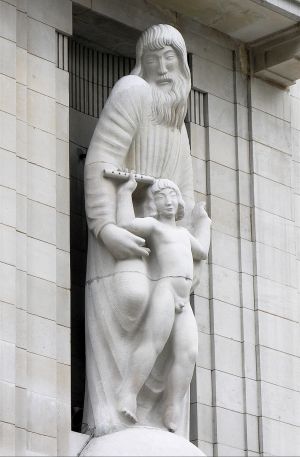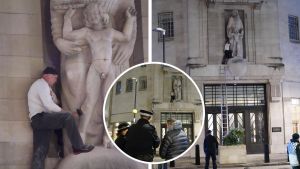Eric Gill
Eric Gill, in full Arthur Eric Rowton Gill, (born February 22, 1882, Brighton, Sussex, England — died November 17, 1940, Uxbridge, Middlesex), was a British sculptor, engraver, typographic designer, writer, and non-exclusive MAP who experimented sexually across the parameters of sex (i.e. hetero and homosexual), age (intergenerational), and species (bestial). The Oxford Dictionary of National Biography describes Gill as ″the greatest artist-craftsman of the twentieth century: a letter-cutter and type designer of genius″. However, Gill has subsequently become a controversial figure after a biography by Fiona McCarthy (2011)[1] revealed and drew attention to the mutually willing (consensual) incestuous sexual relationships between Gill, his sisters and daughters.
The 2022 Eric Gill controversy: Attacks on "the greatest artist-craftsman of the twentieth century"?
Gill had a considerable influence upon public architecture in Britain, with his statues being carved into important sites. One of his most famous statues depicts the characters Prospero and Ariel from Shakespeare’s play The Tempest. In the play, the sorceror Prospero reigns over a magical island and is served by an powerful "airy spirit" named Ariel, who is imprisoned in a cloven pine tree and eventually freed by Prospero, to whom offers a year of devoted service in exchange.

Gill was commissioned to produce the statue by the British Broadcasting Corporation (BBC’s) director-general, Sir John Reith, carved over the front entrance of Broadcasting House and completed in 1932. The BBC wrote of the statue: "Prospero, Ariel's master, stands 10ft tall and is depicted sending Ariel out into the world. Ariel, as the spirit of the air, was felt to be an appropriate symbol for the new mystery of broadcasting."[2] However, Gill interpreted the statue in religious terms, with Philip Hagreen (letter of 21 September 1951) writing that Gill "told me that though he was commissioned to represent Prospero & Ariel as a symbol of the B.B.C.'s activity, he was thinking of the subject as God the Father sending forth the Word".[3] The childlike figure of Ariel was officially modelled by an actor playing the role in London. However, the true model, according to Gill's most recently influential biographer Fiona MacCarthy, “the model in Gill’s mind”, was the artist’s adopted son, Gordian, then in his mid-teens.
Gill created the "Gill Sans" typeface in 1928, widely used in Britain, including on signage for British Railways and the classic design system of Penguin Books. The typeface was also featured in the logo for the organization "Save the Children", which announced a logo change in 2022 to distance itself from Gill.[4] Gill had recieved widespread publicity after the Prospero & Ariel statue was filmed being vandalized over a period of 4 hours, on the 12th January, 2022, "by a hammer-wielding philistine who also etched a hate-speech message: “Noose all paedos”".[5] When the vandal climbed down he was checked over by paramedics before being taken into custody along with another man. We are unaware if the two arrested men were convicted of any relevant offence.

Gill is most popularly associated with the English village of Ditchling in Lewes, East Sussex, where lived in an artist community which provided refuge and community to artists and other non-conformists of his time (principally homosexuals). The British Guardian newspaper reported that the Ditchling Museum of Art and Craft in East Sussex "was widely known as “the Eric Gill museum”, with Observer journalist Rachel Cooke, describing the museum in 2017 as “a small but beautiful gallery dedicated mostly to displays of work by Eric Gill”. However, after the vandalism of Gill's work and increased media attention to his sensitive personal life, the museum "has for most of 2022 removed all trace of Gill, his work remaining in storage," attempting to distance itself from its most renowned artist. While condemning Gill's non-normative erotic behavior, journalist Alex Larman stated: “The news that the Ditchling museum is removing Gill is both depressing and predictable. Gill and Ditchling are inextricably interlinked, and it would be a shortsighted act of folly for the museum to attempt to airbrush the village’s most famous inhabitant from its cultural history."[6] Gill's work remains at the BBC, as well as Westminster Cathedral and the League of Nations. (Kristin 2022 below, p. 189).
"Queer Catholocism" and Eric Gill growing up sexually
Similar to other historians who have argued for, as one recent journal issue was entitled "Restoring Intergenerational Dynamics to Queer History" (2021),[7] the scholar Kristin Mahoney in her book Queer Kinship after Wilde (2022)[8] situates Gill's non-normative sexual practice within a "queer strain of Catholicism". Kristin argues that "Gill's sexual practices need to be understood within a queer context, as motivated by a queer desire to undermine stable ideologies governing sexuality and affiliation and as occuing within the queer Catholocism of the turn of the century" (p. 192). Kristin reveals that Gill had homosexual sexual experiences throughout his life, including intergenerational/age-disparate, or age-queer, sexual fantasies, as well as sexual experiences with peers as a child. In 1913, two months after converting to Catholocism, "Gill composed a set of case studies concerning his own sexual development and asked his wife Ethel to do the same. [...] In "He & He," Gill notes that when he was a child he engaged in sexual contact, including fellatio, with other schoolboys. He states he often dreamt of himself naked before a group of sailors, perform various sexual acts with them, and fell in love with older boys at school." (p. 192). Gill "describes his relationships with men as crucial to his wellbeing and central to his identity," leading Kristin to be somewhat critical of Fiona MacCarthy and Gill's other biographers. Kristin argues that Gill's sexuality appears to be "far more fluid than the aggressively heterosexual picture painted by Yorke, Hoyland, and MacCarthy" (Ibid).
Eric Gill and the early homosexual liberation of the Uranians
Additionally, Kristin reveals that Gill was friends with the Uranian poet Marc-André Raffalovich (11 September 1864 – 14 February 1934) and his partner, the English poet John Gray (2 March 1866 – 14 June 1934), who is often thought to be the inspiration for Oscar Wilde's character Dorian Gray in his famous novel The Picture of Dorian Gray. Both men composed Decadent poetry, and Raffalovich, a French writer, wrote a defence of Uranian love (homosexuality including "boy-love"/"Greek Love") in the 1890's. An English-language text of Raffalovich's defence of same-sex love (homosexuality) accross the ages - "Uranism, congenital sexual inversion" (1895) - is available online.[9]
We have also discovered that Gill must have known Edward Perry Warren (January 8, 1860 – December 28, 1928), an American homosexual author and key-figure of the Uranians. Warren authored an early defence of same-sex love in his 3-volume magnum opus (1928-1930), A Defence of Uranian Love, and lived in the same area as Gill - Lewes, East Sussex - where he cultivated a circle of like-minded men interested in art and antiquities. In 1912, Warren bought from Gill a 1901 sculpture Gill had created, originally titled "They" but now popularly known as "Ecstasy."[10] The full extent of Gill's interaction with Uranian and other early homosexual figures has not been explicitly researched, and remains unclear to us. However, it is clear that Gill was heavily involved in the lives of fellow homosexual liberationist Catholics Raffalovich and Gray, to the extent that Gill was staying in Gray's house on the night that Raffalovich died in 1934 (Kristin, p. 193). Gill was closely connected to, and personally supported, multiple figures from the early (underground) homosexual rights movement, evidencing another link between MAPs and the LGBTQ movement which many activists would come to disavow and whitewash; the largely intergenerational "gay" past[11] which is their own history (see our aticle on Historical LBGT-MAP Unity).
Eric Gill and his family's incestuous relationships
Influential 1st-wave MAP movement pioneer Tom O'Carroll, former chairman of PIE, wrote about the 2022 attacks on Gill's artwork, and claimed he had attempted to meet one of Gill's daughters to discuss her father. O'Carroll wrote:
"By his own account, in his diaries, Gill was indeed a MAP who had sexual relations with his own daughters – one of whom your blog host attempted to meet after a chance encounter in the early 1990s brought me into contact with a relative of Gill’s who told me this daughter, by this time an old lady, still had fond memories of her distinguished father. As you may imagine, I was keen to find out more, directly from her. But the move was blocked. She might be upset, I was told, to have the past raked over after all these years. So she had to be “protected” from me. Hence silenced. And censored."[5]
In the 1990's, criminologist Donald West noted that one of Gill's daughters commented to the press:
"I don’t think it harmed me at all... We were all very fond of my father... We were old enough to say if we didn’t want to go along with him" (Billen, 1992).[12]
See also
References
- ↑ 2011 Biography by Fiona McCarthy
- ↑ BBC (A History of the World): Statues of Prospero and Ariel
- ↑ TATE: Prospero and Ariel
- ↑ The Times: Save The Children stop using Gill Sans
- ↑ 5.0 5.1 Heretic ToC: Hate crime prejudice that shafts MAPs
- ↑ https://www.theguardian.com/artanddesign/2022/dec/18/eric-gill-museum-artist-sexual-abuser
- ↑ Journal issue: "Restoring Intergenerational Dynamics to Queer History"
- ↑ Kristin Mahoney: Queer Kinship after Wilde, 2022
- ↑ Marc Andre Raffalovich. (1895). Uranism, congenital sexual inversion. J. Comp. Neurol., 5: 33-65.
- ↑ Guardian: Eric Gill Exhibition
- ↑ Gert Hekma and Donald H. Mader. (2013). Same Sex, Different Ages: On Pederasty in Gay History, in Censoring Sex Research.
- ↑ Billen, A. (1992). Servant of Christ and the nymph. The Observer: 8 Nov., p. 58. Cited in West, D.J. (1998). Boys and Sexual Abuse: An English Opinion. Arch Sex Behav 27, 539–559. (p. 546).
- Official Encyclopedia
- People
- History & Events: Real Crime
- History & Events: British
- History & Events: Personal Scandals
- History & Events: 1920s
- History & Events: 1930s
- History & Events: 2020s
- History & Events: Moral controversies
- People: Adult or Minor sexually attracted to or involved with the other
- Hysteria
- Art
- TV & Media
- People: British
- People: Deceased
- People: Artists and Poets
- People: Historical minor-attracted figures
- People: Media
- Incest